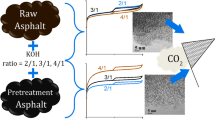This paper presents a comparative study into the specific surface area (BET) and the volume and pore size (BJH) of carbon additives for slurry-phase reactors of the Veba Combi Cracking (VCC) process. The main textural parameters of carbon additives affecting the conversion rate of asphaltene nanoaggregates in the reaction medium of the VCC process were determined. The size of asphaltene nanoaggregates was assessed by laser diffraction in a toluene solution, simulating the reaction mixture. It was shown that the original carbon additive proposed by the VCC technology licensor (USA) and its Russian analogue provide for asphaltene conversion only at the expense of the outer specific surface, since their pore space remains inaccessible due to the small pore size. The treatment of carbon additives with water steam at a temperature of 800°C and heat treatment in nitrogen atmosphere at a temperature of 400°C led to a significant increase in the volume of their pore space and pore diameter, thus facilitating adsorption of asphaltene nanoaggregates on the interstitial surface. Involvement of the pore space of carbon additives into the adsorption of asphaltenes enhances their conversion in the reaction medium of the VCC process.

Similar content being viewed by others
References
A. Nosova, S. Petrov, A, Safiulina et al., Pet. Sci. and Technol., 36, No. 13, 1001–1006 (2018).
S. M. Petrov, D. A. Ibragimova, Ya. I. Abdelsalam et al.., Pet. Chem., 56, No. 1, 21–26 (2016).
L. R. Baibekova, S. M. Petrov, I. I. Mukhamatdinov et al., Int. J. Appl. Chem., 11, No. 5, 593–599 (2015).
A. I. Lakhova, S. M. Petrov, R. R. Zakieva et al., Res. J. Appl. Sci., 10, 917–921 (2015).
S. Petrov, A Nosova, N. Bashkirtseva et al., IOP Conference Series: Earth and Environmental Science, 282, No. 1, 012004 (2019).
G. P. Kayukova, V. P. Morozov, R. R. Islamova et al., Chemistry and Technology of Fuels and Oils, 51, No. 1, 117–126 (2015).
I. Zaidullin, A. Pitsenko, A, Safiulina et al., Chemistry and Technology of Fuels and Oils, 54, No. 5, 550–556 (2018).
A. Lakhova, R. Soldatova, S. Petrov et al., Pet. Sci. and Technol., 37, No.5, 611–616 (2019).
S. M. Petrov, R. R. Zakiyeva, Ya. I. Abdelsalam et al., Int. J. Appl. Eng. Res., 10, No. 24, 44656–44661 (2015).
L. R. Baibekova et al., International Journal of Applied Chemistry, 11, No. 5, 593–599 (2015).
A. Lakhova et al., Petroleum Science and Technology, 37, No. 5, 611–616 (2019).
S. Petrov, R. Soldatova, and A. Lakhova, IOP Conference Series: Earth and Environmental Science, 282, No. 1, 012015 (2019).
R. N. Magomedov, A. Z. Popova, T. A. Maryutina et al., Neftekhimiya [In Russian], 55, No. 4, 267–267 (2015).
V. Kapustin, E. Chernysheva, and R. Khakimov, Processes, 9, No. 3, 500 (2021).
A. K. Shigabutdinov et al., IOP Conference Series: Earth and Environmental Science, 1070, No. 1, 012024 (2022).
Russian Federation Patent 2654852 C2, Method for Introducing Small and Large Additives for Hydroconversion of Heavy Hydrocarbons [In Russian], claimed by A. Shlajffer and A. Subramanian (2013).
S. V. Monastyrev, Promyshlennost’. Khimicheskie tekhnologii [In Russian], No. 15., 213–215 (2016).
M. Alhreez and D. Wen, RSC advances, 9, No. 34, 19560–19570 (2019).
M. R Gray. et al., Energy & Fuels, 35, No. 22, 18078–18103 (2021).
V. M. Kapustin and E. A. Chernyshova, Proceedings of the 8th International Scientific and Technical Conference “Technique and Technology of Petrochemical and Oil and Gas Production” [In Russian], 24–25 (2018).
S. M. Petrov, A. G. Safiulina, N. Y. Bashkirtseva et al., Processes, 9, 2, 256 (2021).
Acknowledgements
The research was conducted out of the Russian Science Foundation Grant No. 18-77-10023, https://rscf.ru/project/18-77-10023/
The investigation was conducted using equipment of the Center of Complex Program “Nanomaterials and Nanotechnologies” of the Kazan National Research Technological University.
Author information
Authors and Affiliations
Corresponding author
Additional information
Translated from Khimiya i Tekhnologiya Topliv i Masel, No. 1, pp. 57–60 January–February, 2023.
Rights and permissions
Springer Nature or its licensor (e.g. a society or other partner) holds exclusive rights to this article under a publishing agreement with the author(s) or other rightsholder(s); author self-archiving of the accepted manuscript version of this article is solely governed by the terms of such publishing agreement and applicable law.
About this article
Cite this article
Petrov, S.M. Study into the Specific Surface Area and Pore Space of Carbon Additives for Veba Combi Cracking (VCC). Chem Technol Fuels Oils 59, 65–68 (2023). https://doi.org/10.1007/s10553-023-01504-w
Published:
Issue Date:
DOI: https://doi.org/10.1007/s10553-023-01504-w




